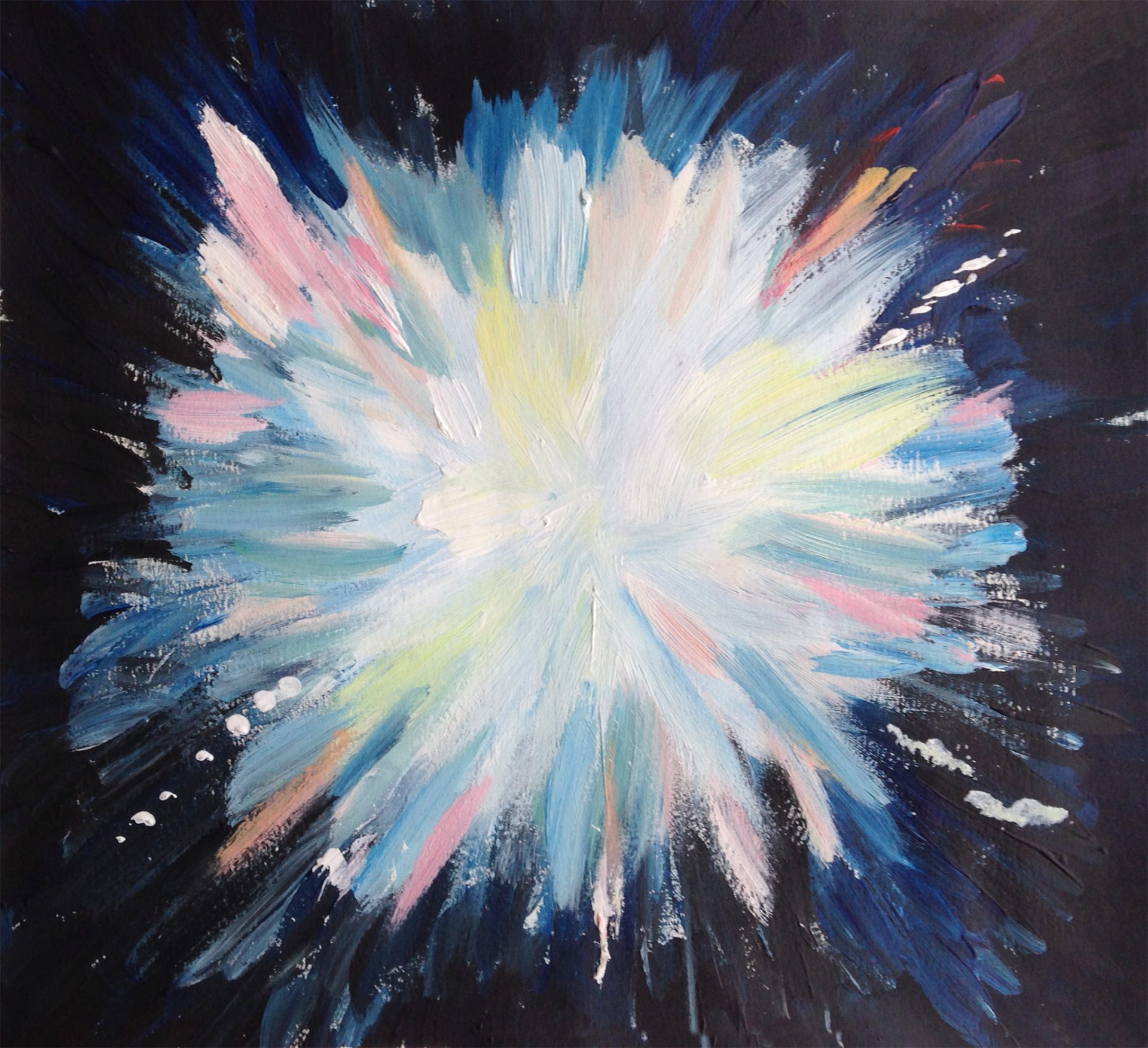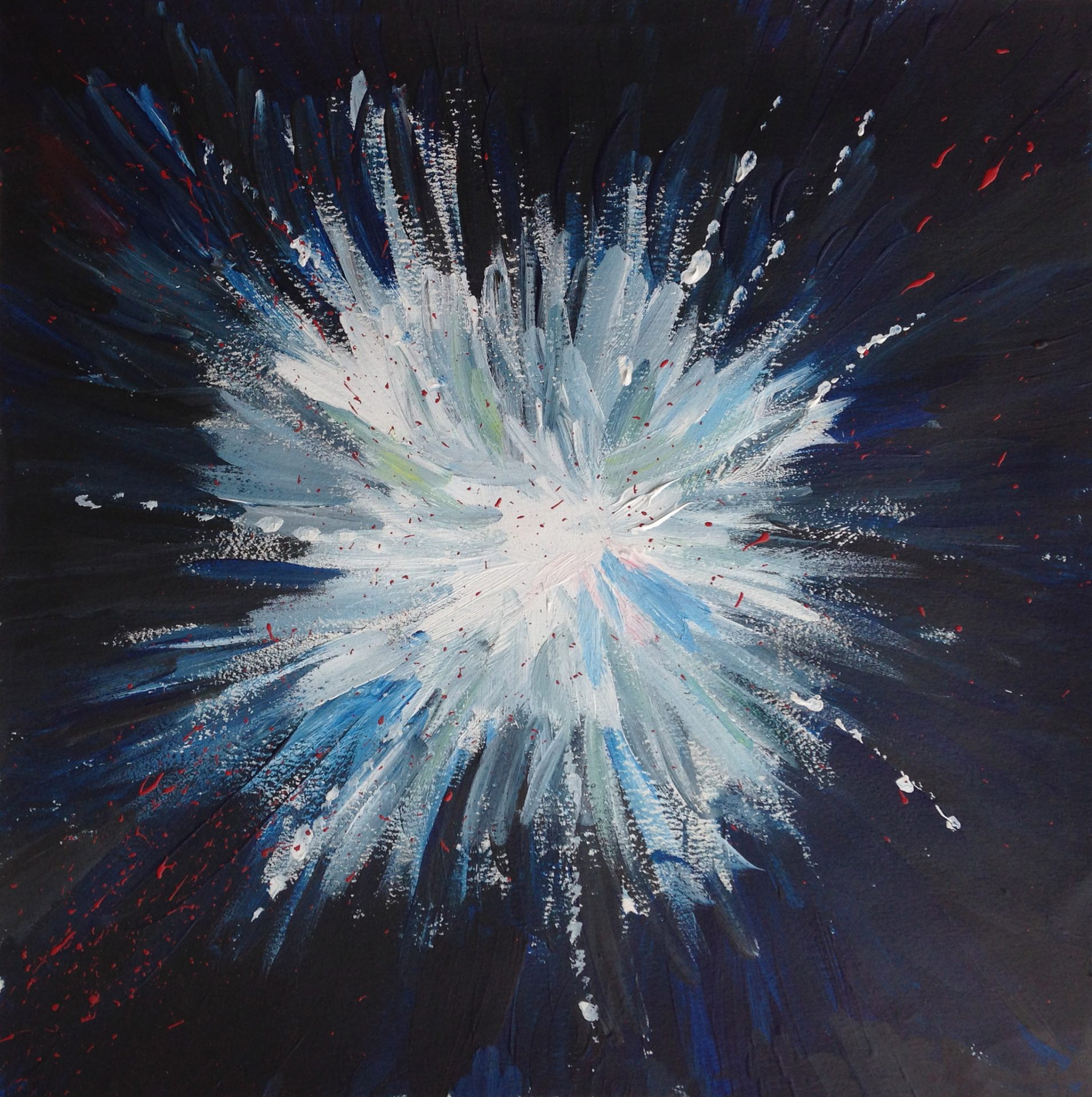The Individuality of Illness
This ability to prosper in difficult circumstances, commonly referred to as resilience, comes from many sources –physical, social and financial positon, combined with less tangible aspects of life such as spiritual and emotional condition. All of the factors contributing are key considerations both when understanding a patient’s, a colleague’s or even one’s own needs. I have created a series of paintings to represent the differences that I have seen in human resilience and have focused on three individuals in particular. This exercise has allowed me to step back and consider how these aspects are fundamentally linked.
I have chosen to make a series of three acrylic paintings; two of the pieces represent patients that I have come across in the course at Bristol so far and the other represents someone that I know personally. I have tried to capture, using colour and texture, an expressive symbol of how these individuals are dealing with their current circumstances. Differences in how they are coping are depicted by the light conquering the darkness that is encroaching from the outside. During a home visit with another student, I spoke to Mrs Madley*, a 65 year old lady with multiple sclerosis. Mrs Madley explained that when she was younger she had not considered her periodic falls and difficulty with certain movements an issue until the trauma of her husband’s death when she was 55 triggered rapid progression of her MS. Mrs Madley explained how she had to endure muscle weakness, general tiredness, difficult walking and balance issues along-side her main concern of crippling muscle spasms. I was amazed by her positivity and her genuine belief that her condition was mind over matter. It was not just her positive personality that helped her to live well, she also used various aids to help her get around the house, used two walking sticks and had helpful neighbours and children that lived nearby. She was able to see her grandchildren regularly, upon whom she clearly doted. Mrs Madley told us that she was financially stable, was having the living room redecorated and was able to afford a modified car so that she could still drive. She explained with fervour her involvement in support groups and in helping others with the disease. Mrs Madley clearly had a solid social foundation and felt independent and empowered. whilst simultaneously supported; her family were there if she needed them but she had the ability to look to the future. The connection between solid social networks and health has long been recognised1 and it seemed clear that this social connectedness was contributing significantly to Mrs Madley’s resilience. I have represented this and the different assets such as a positive personality and financial stability using different colours that accompany the first picture which I have painted to show how brightly Mrs Madley comes across.
Other patients appear to be able to remain positive without such varied resources. Mr Pritchard was a man with Parkinson’s Disease whom I met on a different home visit. He had made the decision to carry on with his life as best he could, refusing to succumb to the various ways that the Parkinson’s affected him. He explained that he did not need or feel compelled to go to support groups and did not want to make modifications to his house even though his illness was progressing. However, Mr Pritchard was clearly happy with this outlook, humour was evident and his wife was loving and happy to help him. Unfortunately, Mr Pritchard explained that he had felt like he had ‘slipped through the net’ with regards to some of his check-ups and had had to ask for a new nurse after the previous one moved to a new hospital and had not been replaced. But he did not seem phased by this, with the support of his wife and his strength of character, Mr Pritchard had clearly been able to maintain a positive attitude towards his illness and terminal prognosis, an undoubtedly challenging accomplishment. Thus without utilising such a vast array of resources, Mr Pritchard was still living a happy life. It has been found that there are significant gender differences in help-seeking behaviour 2 and the contrast between how the two patients discussed dealt with their illness made me consider whether this may be a contributing factor. It may be that as at time goes on he will become more accepting of the resources around him if he feels he needs them but meeting him made me aware of the significant impact of personality with regards to help seeking behaviour. Mr Pritchard is represented in the second painting, where the flecks of red are his illness, trying to come through, his strong, spirit remains shining brightly.
For other individuals, circumstances prove too much for them to overcome at certain points in their life. My final painting represents someone retreating away from society due to their illness, and is inspired by a 18 year old Annie. Annie has had an eating disorder since she was in her early teens. Despite having resources available including watchful friends and a caring family, Annie has struggled through bouts of recovery and remission. The painting represents moments when she cannot or will not seek help. It is well known that the patients that are seen in the general practitioner’s surgery are just a small number of those in the community and potentially suffering with an illness or condition. This shows that a crucial aspect of resilience is being able to ask for help from the places that are best equipped to provide it. Again this is dependent upon the environment, social and economic factors and the physiological frame of mind that someone finds themselves in. Western society is one that sets out norms and standards which can be extremely oppressive, and when issues arise, sometimes these norms prevent people from admitting that they have issues and need help. I have tried to represent their struggle using a lack of colour and an increased proportion of the image in darkness.
I think this creative enquiry has helped me in many respects both with regards to my own state of both mental and physical well-being and will also broaden my thought process when I offer guidance to patients. I can see how important it is to consider the person in their entire environment and not just what is presented in a consultation. I can also explore the variety of different ways in which people can require assistance and acknowledge they can be suffering on more than one level of well-being. Furthermore I understand the importance of ensuring that the correct help is given once people have been brave enough to ask for help or admit that they need more guidance.
*Consent was obtained for all patients included in this piece of work. All names have been changed for anonymity
References 1. Lubben, J. E. Family & Community Health, November 1988, Volume 11, Issue 3, pg 42-52
2. Wang, Y., Hunt, K., Nazareth, Freemantle, N. and Petersen , I. 2013 Do men consult less than women? An analysis of routinely collected UK general practice data. British Medical Open. Volume 3, Issue 8



Before even reading the reflection I could already feel the individuals characters coming across through the art. Spending time volunteering at a MS therapy centre myself, I can relate to the variation just one illness can have on different patients and just how diversely they cope. I love how the art truly mimics this and really represents the individuality that each person deserves. Appreciating their character allows for doctors to be able to give the patients the extra care and little details that they need. I feel through the three cases represented here, you have managed to show three very different ways of resilience, each unique in their own rights. Really beautiful pieces, well done. 🙂